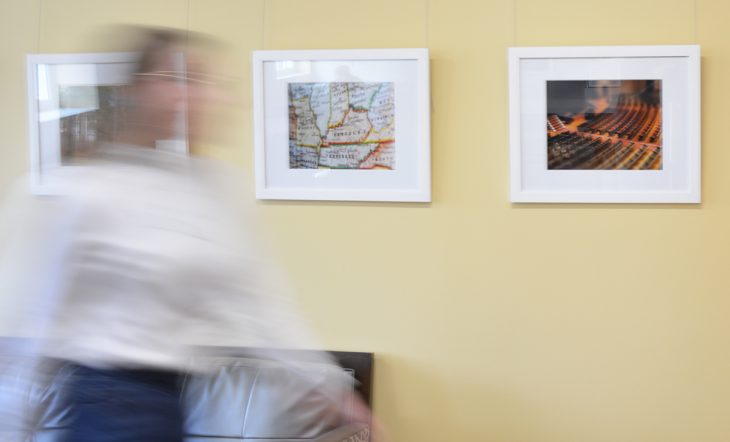
For Anthony Mead, director of Transylvania University’s Morlan Gallery, evaluating the campus’s artwork and placement with an eye toward increasing student representation is a way to build community while also creating an aesthetically pleasing space. Mead remembers his time as an undergraduate studying next to pieces of art that he still misses, noting that art “has a way of giving people a sense of belonging and telling a story in a way that really connects emotionally with people.”
In May 2022, Mead began chairing a campus Visual Arts Committee composed of members from multiple areas of campus, making a conscious decision to represent different voices and constituencies when selecting campus artwork.
Along with Mead, representatives from the Office of Marketing and Communications, the director of the library, director of spirituality and religious life, vice president for diversity and inclusion and a studio art faculty member are all involved in the decision-making process. This particular composition allows the committee to consider the artwork as part of the university’s overall presentation, while ensuring that Transylvania’s history is honored, people from all backgrounds are represented and student perspectives are intentionally considered.
Committee member Susan Brown, director of the library, has extensive experience supporting student art. Since joining Transylvania in 2002, she has filled the library with an array of student artwork, often personally purchasing pieces directly from the juried student art show, an annual event in Morlan Gallery open to all enrolled Transylvania students.
“I wanted to make sure that the library had representative artwork from our students,” Brown said. “Students can look around at the walls and say, ‘Hey, that’s someone who is also a student.’”
“I’m excited that the committee has been formed and we’re taking a look at what’s being placed in the different buildings,” she added, noting that the committee structure means that artwork is now chosen “in a more democratic way so that there’s more representation from various folks around campus.”
The committee initially identified high-priority areas around campus — including the Old Morrison Chapel, Carpenter Center and Campus Center — and worked to place or replace art in those spaces.
The first change took place in the Old Morrison Chapel, where the committee selected two pieces from the most recent juried student art show. Resembling large tapestries, the art embodied “a certain spirit that was appropriate for that place,” Mead explained.
Changes were also made in multiple Campus Center locations, including a hallway on the second floor, the hallway outside of classroom 118 and in the Hearth Room.
The second floor space, located outside of the health clinic and Student Life lounge, had traditionally displayed SGA artwork, and the committee wanted students to continue to have control of the area. In order to make it easier for students to rotate the artwork on a semiregular basis, they installed a temporary art hanging system before reinstalling the original art, including images inspired by the COVID-19 pandemic and Black Lives Matter movement.
The inclusion of these art rail systems, which were installed in each location, allows the committee to alternate between more permanent and transient installations. “We’re keeping campus exciting and fresh and putting new ideas out on the walls,” Mead said.
The hallway outside of classroom 118 provided an ideal opportunity to display a suite of woodblock relief prints by local artist Derrick Riley. “Kentucky Monster Mash Series 1-8,” which depicts a variety of Kentucky-based monster stories, is a natural fit for an institution with an interest in the uncanny. At Transylvania, “we tend to really embrace things like Halloween, so we thought the monster stories and folklore done by a local artist would be a great thing to showcase,” Mead explained.
“The Hearth Room is like the living room or den of the university, a space where you’re really comforted, so we wanted a piece of artwork that conveyed the feeling of really being able to cozy up by the fire,” Mead said. For this space, the committee chose a piece that would feel warm, soft and inviting to reflect the room’s atmosphere, selecting a student-made, Pine Mountain-inspired quilt from one of art professor Zoé Strucker’s classes.
In the Carpenter Center, the committee identified multiple spaces to place artwork, including hallways on the second and third floors of the building, as well as a kitchen and lounge area. A wide variety of pieces from the Transylvania collection, including Dean’s Purchase Award recipients from the annual juried student art show, now grace those spaces.
The second floor lounge features a series of photographic images of spaces around the Commonwealth. Commissioned by a former Transylvania president and taken by Transylvania students, the images give a sense of place and home to the space, livening up the common areas while also serving as inspiration to students, who may know — or even be — some of the featured artists.
Mead, who sees the Visual Arts Committee as a long-range project, hopes that students will also bring their voices to the nascent committee in the future. “I think having a group of people that make really intentional choices about the artwork on campus allows a space to exist where we can tell stories about others and ourselves in a positive way and create spaces that give a sense of belonging,” he said. “Bringing more artwork to campus is another way to infuse the humanities aspect of the liberal arts experience into the daily life of everyone here.”

